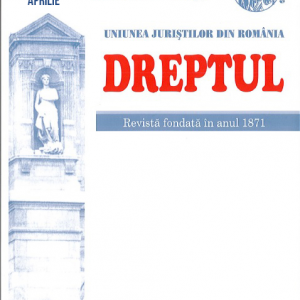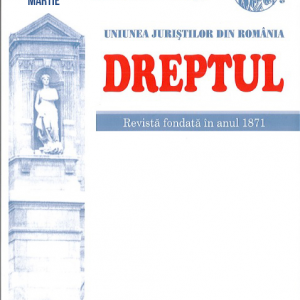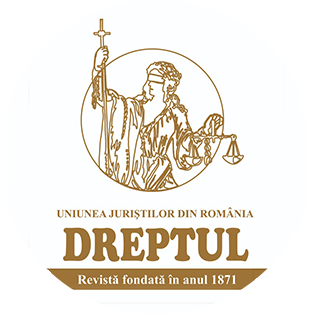-
 In this study, the author analyzes the essential changes that the year 2011 has brought with respect to the dismissal of the trade union leader under Law no. 40/2011 (amending and supplementing the Labour Code), and also under Law no. 62/2011 regarding social dialogue. At the end of the analysis, the author concludes that these changes are both in accordance with the Romanian Constitution, as well as with the applicable European regulations.
In this study, the author analyzes the essential changes that the year 2011 has brought with respect to the dismissal of the trade union leader under Law no. 40/2011 (amending and supplementing the Labour Code), and also under Law no. 62/2011 regarding social dialogue. At the end of the analysis, the author concludes that these changes are both in accordance with the Romanian Constitution, as well as with the applicable European regulations. -
 As a result of the substance amendments brought to the Labor Code (Law no. 53/2003) according to Law no. 40/2011, followed in a short period of time, by the enactment of Law no. 62/2011 of social dialogue, certain contradictions were generated between the Labor Code (as republished on 18 May 2011) and Law no. 62/2011, generating a series of controversies in the Romanian judicial doctrine. Some of these controversies are reexamined by the author of this study who, after debating them, reaches certain interesting conclusions.
As a result of the substance amendments brought to the Labor Code (Law no. 53/2003) according to Law no. 40/2011, followed in a short period of time, by the enactment of Law no. 62/2011 of social dialogue, certain contradictions were generated between the Labor Code (as republished on 18 May 2011) and Law no. 62/2011, generating a series of controversies in the Romanian judicial doctrine. Some of these controversies are reexamined by the author of this study who, after debating them, reaches certain interesting conclusions. -
 The author considers that article 288 paragraph (1) of the National Education Law no. 1/2011 (text according to which the didactic activities exceeding a didactic workload are remunerated for each hour worked, and for the tenured didactic staff – in the higher education system – the maximum number of paid hours in the regime of payment per hour, no matter the educational establishment where the respective hours are worked, cannot exceed the minimum didactic workload) breaches the provisions of the Constitution of Romania, even though the Constitutional Court adjudicated otherwise under the decision no. 1090/2011. The basic argument forwarded by the author is that, in case of certain similar regulations contained in the contents of certain previous similar legislative instruments (Law no. 88/1993 and Law no. 128/1997), the same Constitutional Court, according to two decisions (no. 114/1994 and no. 30/1998) ruled otherwise than it had ruled in 2011 (that is, it stated that those decisions were unconstitutional).
The author considers that article 288 paragraph (1) of the National Education Law no. 1/2011 (text according to which the didactic activities exceeding a didactic workload are remunerated for each hour worked, and for the tenured didactic staff – in the higher education system – the maximum number of paid hours in the regime of payment per hour, no matter the educational establishment where the respective hours are worked, cannot exceed the minimum didactic workload) breaches the provisions of the Constitution of Romania, even though the Constitutional Court adjudicated otherwise under the decision no. 1090/2011. The basic argument forwarded by the author is that, in case of certain similar regulations contained in the contents of certain previous similar legislative instruments (Law no. 88/1993 and Law no. 128/1997), the same Constitutional Court, according to two decisions (no. 114/1994 and no. 30/1998) ruled otherwise than it had ruled in 2011 (that is, it stated that those decisions were unconstitutional). -
 In this study has been underlined that the right to property is a fundamental component of Human Rights, of the European and International Rights of every human being. Have been put forward the main scientific contributions in the European Culture of Human Rights and has been demonstrated in which manner the right to property is guaranteed in the European practice and in Romania after 1989. It is underlined that the normal life of every human being is not possible in the absence of those guarantees that his right to property is fully respected.
In this study has been underlined that the right to property is a fundamental component of Human Rights, of the European and International Rights of every human being. Have been put forward the main scientific contributions in the European Culture of Human Rights and has been demonstrated in which manner the right to property is guaranteed in the European practice and in Romania after 1989. It is underlined that the normal life of every human being is not possible in the absence of those guarantees that his right to property is fully respected. -
 The forgery of credit titles or payment instruments represents an offence prejudicing the financial stability of the monetary system. In this article, the author deals with the matter of the scope of the terms such as credit title and payment instrument, examining the concrete ways of committing the offence in the judicial practice of the courts, as well. The author states that close attention should have been paid to explain the amendment of constituent items of the offence in the explanatory statement accompanying the new Criminal Code, in order to avoid the differences related to interpretation in the matter and in the judicial practice.
The forgery of credit titles or payment instruments represents an offence prejudicing the financial stability of the monetary system. In this article, the author deals with the matter of the scope of the terms such as credit title and payment instrument, examining the concrete ways of committing the offence in the judicial practice of the courts, as well. The author states that close attention should have been paid to explain the amendment of constituent items of the offence in the explanatory statement accompanying the new Criminal Code, in order to avoid the differences related to interpretation in the matter and in the judicial practice. -
 The author points out that article 77 of the new Criminal Code reassessed the circumstances having the ability to emphasize a high degree of social danger of the committed offence and of the offender. Thus, the scope of the circumstance relates to the perpetration of the offence by a person being in a preordinate intoxicated condition which may be generated besides the alcohol, by other psychoactive substances, whose consumption represents a breach of a legal or medical interdiction. The aggravation of the criminal liability has been waived in case the offence is committed for infamous reasons, as the content of this circumstance has never been precisely determined by the doctrine and jurisprudence. A new aggravating circumstance has been introduced consisting in the perpetration of the offence by taking advantage of the obvious vulnerable condition of the injured person due to his/her age, health condition, disability of due to some other grounds, as such a circumstance emphasizes a high level of gravity of the offence, but also a degree of increased injuriousness of the offender. Another novelty item is represented by the waiver to the category of judicial aggravating circumstances, because the imprecise manner in which they are regulated would be situated at the edge limit of the principle of the predictable nature of law.
The author points out that article 77 of the new Criminal Code reassessed the circumstances having the ability to emphasize a high degree of social danger of the committed offence and of the offender. Thus, the scope of the circumstance relates to the perpetration of the offence by a person being in a preordinate intoxicated condition which may be generated besides the alcohol, by other psychoactive substances, whose consumption represents a breach of a legal or medical interdiction. The aggravation of the criminal liability has been waived in case the offence is committed for infamous reasons, as the content of this circumstance has never been precisely determined by the doctrine and jurisprudence. A new aggravating circumstance has been introduced consisting in the perpetration of the offence by taking advantage of the obvious vulnerable condition of the injured person due to his/her age, health condition, disability of due to some other grounds, as such a circumstance emphasizes a high level of gravity of the offence, but also a degree of increased injuriousness of the offender. Another novelty item is represented by the waiver to the category of judicial aggravating circumstances, because the imprecise manner in which they are regulated would be situated at the edge limit of the principle of the predictable nature of law. -
 In this study, the author carries out a critical analysis of the provisions of articles 508-534 of the current Civil Code (Law no. 287/2009, as republished on 15 July 2011 and which came into force on the 1st of October 2011), texts which regulate „the legal obligation to support”. Essentially, the author, after emphasizing a series of new judicious and useful regulations of the above mentioned texts of the current Civil Code shows at the same time numerous deficiencies of articles 508-534 of the Civil Code which has recently become effective and which, in his opinion, involves many amendments, supplements and even abolitions of the concerned rules.
In this study, the author carries out a critical analysis of the provisions of articles 508-534 of the current Civil Code (Law no. 287/2009, as republished on 15 July 2011 and which came into force on the 1st of October 2011), texts which regulate „the legal obligation to support”. Essentially, the author, after emphasizing a series of new judicious and useful regulations of the above mentioned texts of the current Civil Code shows at the same time numerous deficiencies of articles 508-534 of the Civil Code which has recently become effective and which, in his opinion, involves many amendments, supplements and even abolitions of the concerned rules. -
 In this study the author analyses the individual amnesty at the level of the constitutional disposition, in the light of the compared law as a prerogative of the head of State. Covering this analysis, the author concludes that the deed of individual amnesty represents a discretionary and sovereign duty known in most cases as a prerogative of the executive body which exercises this prerogative being able to pardon, usually, without any justification, any individual, no matter the offence he/she committed, provided that he/she was finally sentenced.
In this study the author analyses the individual amnesty at the level of the constitutional disposition, in the light of the compared law as a prerogative of the head of State. Covering this analysis, the author concludes that the deed of individual amnesty represents a discretionary and sovereign duty known in most cases as a prerogative of the executive body which exercises this prerogative being able to pardon, usually, without any justification, any individual, no matter the offence he/she committed, provided that he/she was finally sentenced. -
 In this study, the author, after having pointed out the need for taking certain measures on combating the organized crime at the European level in compliance with the actions of the United Nations Organization in the matter, discloses, on one hand, the measures adopted at the level of the European Union regarding the incrimination of deeds regarding the crime organization and, on the other hand, examines the provisions of the framework decision of the Council 2008/ 841/JAI of 24 October 2008 regarding the fight against organized crime. Likewise, the author describes the implications of these measures on the criminal laws of Romania.
In this study, the author, after having pointed out the need for taking certain measures on combating the organized crime at the European level in compliance with the actions of the United Nations Organization in the matter, discloses, on one hand, the measures adopted at the level of the European Union regarding the incrimination of deeds regarding the crime organization and, on the other hand, examines the provisions of the framework decision of the Council 2008/ 841/JAI of 24 October 2008 regarding the fight against organized crime. Likewise, the author describes the implications of these measures on the criminal laws of Romania. -
 Certain considerations are mentioned in this study regarding the privilege of the confidentiality of the journalists’ information sources. To this end, there is carried out an interesting description of the European conception on the confidentiality of information sources (case law of the European Court of Human Rights; Swedish, German, British, Belgian, French laws), of the conception in the matter of the laws and case law of the United States of America, as well as of the Romanian conception, finally. The study concludes by emphasizing the need for the adoption of a modern Romanian mass-media law, pointing out that the freedom of the media can never be absolute and consequently, may be limited by legal exception rules of interpretation strictly.
Certain considerations are mentioned in this study regarding the privilege of the confidentiality of the journalists’ information sources. To this end, there is carried out an interesting description of the European conception on the confidentiality of information sources (case law of the European Court of Human Rights; Swedish, German, British, Belgian, French laws), of the conception in the matter of the laws and case law of the United States of America, as well as of the Romanian conception, finally. The study concludes by emphasizing the need for the adoption of a modern Romanian mass-media law, pointing out that the freedom of the media can never be absolute and consequently, may be limited by legal exception rules of interpretation strictly. -
 The globalization phenomenon is inevitably leading to a development, without precedent, of the international trade, in general, and of the freight, a situation that emphasizes the current complex issue of defining the law applicable to the international contract of maritime freight, and also the enhancement of afforts for the elaboration of an uniform frame applicable to international trade contracts in general, by the specialized institutions – UNCITRAL, UNIDROIT, the Hague Conference on international private law; the existence of an uniform law proves to be the best solution in order to avoid difficult issues caused by the conflict of laws, process which is constantly developing without achieving the elaboration of an universal interstate convention, that could unify the conflict solutions applicable to all international trading contracts, and consequently, at least for the time being, the conflict of laws is not completely eliminated. From this perspective, the law applicable to the international charter party has been analyzed according to the European Committee Regulation no. 593/ 2008 of the Europea Parliament and Council regarding the law applicable on contractual obligations – Rome I, and according to the inter-American Convention on the law applicable on international contracts (CIDIP Convention).
The globalization phenomenon is inevitably leading to a development, without precedent, of the international trade, in general, and of the freight, a situation that emphasizes the current complex issue of defining the law applicable to the international contract of maritime freight, and also the enhancement of afforts for the elaboration of an uniform frame applicable to international trade contracts in general, by the specialized institutions – UNCITRAL, UNIDROIT, the Hague Conference on international private law; the existence of an uniform law proves to be the best solution in order to avoid difficult issues caused by the conflict of laws, process which is constantly developing without achieving the elaboration of an universal interstate convention, that could unify the conflict solutions applicable to all international trading contracts, and consequently, at least for the time being, the conflict of laws is not completely eliminated. From this perspective, the law applicable to the international charter party has been analyzed according to the European Committee Regulation no. 593/ 2008 of the Europea Parliament and Council regarding the law applicable on contractual obligations – Rome I, and according to the inter-American Convention on the law applicable on international contracts (CIDIP Convention). -
 Commenting on a judgment pronounced by Craiova Court of Appeal, the author makes certain considerations related, on one hand, to the prosecutor’s right to declare the appeal regarding the civil side for lack of appeal of the civil party and, on the other hand, to the effects of the second appeal in the criminal proceedings.
Commenting on a judgment pronounced by Craiova Court of Appeal, the author makes certain considerations related, on one hand, to the prosecutor’s right to declare the appeal regarding the civil side for lack of appeal of the civil party and, on the other hand, to the effects of the second appeal in the criminal proceedings.
